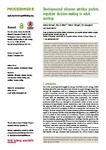Developmental telomere attrition predicts impulsive decision-making in adult starlings
| dc.contributor.author | Bateson, M | en |
| dc.contributor.author | Brilot, BO | en |
| dc.contributor.author | Gillespie, R | en |
| dc.contributor.author | Monaghan, P | en |
| dc.contributor.author | Nettle, D | en |
| dc.date.accessioned | 2015-10-21T16:28:26Z | |
| dc.date.available | 2015-10-21T16:28:26Z | |
| dc.date.issued | 2015-01-22 | en |
| dc.identifier.issn | 0962-8452 | en |
| dc.identifier.other | 20142140 | en |
| dc.identifier.uri | http://hdl.handle.net/10026.1/3692 | |
| dc.description.abstract |
<jats:p> Animals in a poor biological state face reduced life expectancy, and as a consequence should make decisions that prioritize immediate survival and reproduction over long-term benefits. We tested the prediction that if, as has been suggested, developmental telomere attrition is a biomarker of state and future life expectancy, then individuals who have undergone greater developmental telomere attrition should display greater choice impulsivity as adults. We measured impulsive decision-making in a cohort of European starlings ( <jats:italic>Sturnus vulgaris</jats:italic> ) in which we had previously manipulated developmental telomere attrition by cross-fostering sibling chicks into broods of different sizes. We show that as predicted by state-dependent optimality models, individuals who had sustained greater developmental telomere attrition and who had shorter current telomeres made more impulsive foraging decisions as adults, valuing smaller, sooner food rewards more highly than birds with less attrition and longer telomeres. Our findings shed light on the biological embedding of early adversity and support a functional explanation for its consequences that could be applicable to other species, including humans. </jats:p> | en |
| dc.format.extent | 0 - 0 | en |
| dc.language | en | en |
| dc.language.iso | en | en |
| dc.publisher | The Royal Society | en |
| dc.title | Developmental telomere attrition predicts impulsive decision-making in adult starlings | en |
| dc.type | Journal Article | |
| plymouth.issue | 1799 | en |
| plymouth.volume | 282 | en |
| plymouth.journal | Proceedings of the Royal Society B: Biological Sciences | en |
| dc.identifier.doi | 10.1098/rspb.2014.2140 | en |
| plymouth.organisational-group | /Plymouth | |
| plymouth.organisational-group | /Plymouth/Faculty of Science and Engineering | |
| plymouth.organisational-group | /Plymouth/REF 2021 Researchers by UoA | |
| plymouth.organisational-group | /Plymouth/REF 2021 Researchers by UoA/UoA04 Psychology, Psychiatry and Neuroscience | |
| dcterms.dateAccepted | 2014-11-06 | en |
| dc.identifier.eissn | 1471-2954 | en |
| dc.rights.embargoperiod | Not known | en |
| rioxxterms.versionofrecord | 10.1098/rspb.2014.2140 | en |
| rioxxterms.licenseref.uri | http://www.rioxx.net/licenses/all-rights-reserved | en |
| rioxxterms.licenseref.startdate | 2015-01-22 | en |
| rioxxterms.type | Journal Article/Review | en |


